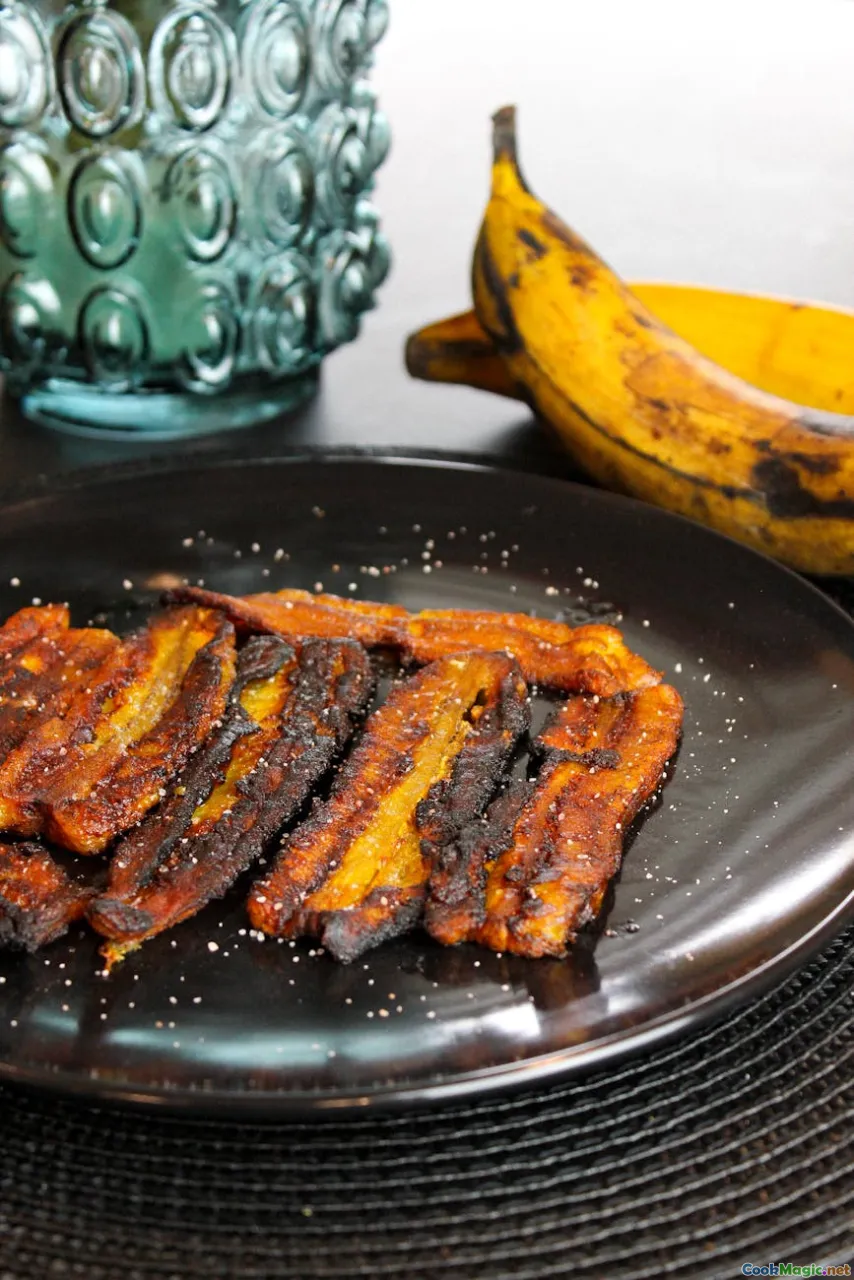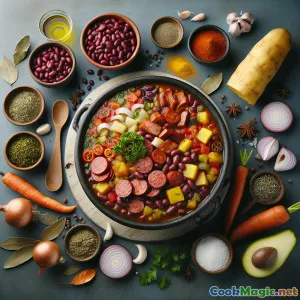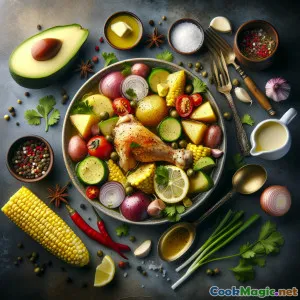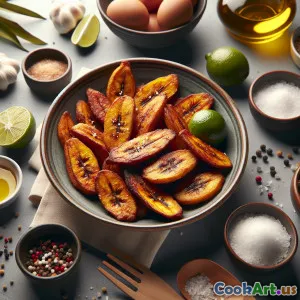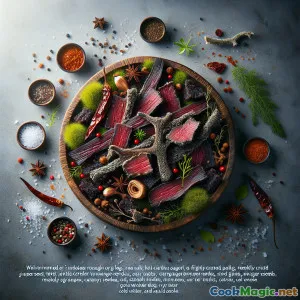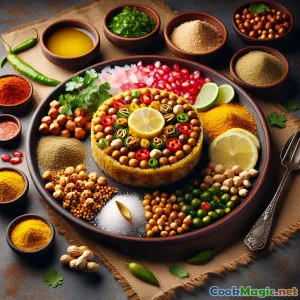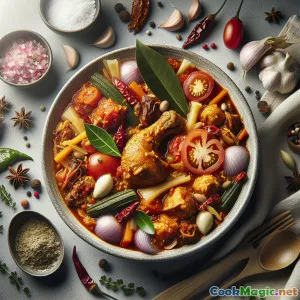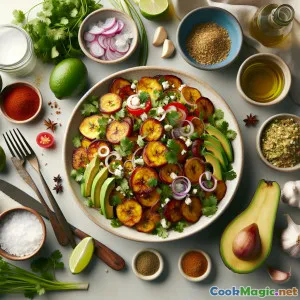
Patacones crocantes com molho de ají-limão
(Crispy Patacones with Lime Aji Dip)
(0 Avaliações)0
150
outubro 22, 2025
Reportar um problema
Ingredientes
-
3 large Banana-da-terra verde (crua)
(Choose firm, very green plantains for maximum crispness.)
-
750 ml Óleo neutro para fritar
(Vegetable, canola, or peanut oil; amount for deep-frying—unused oil can be saved.)
-
1.5 tsp Sal grosso kosher
(Season to taste; fine salt adheres best.)
-
15 grams Coentro fresco (folhas e talos macios)
(For the lime aji dip.)
-
2 cloves Dentes de alho, picados
(For the dip; adjust to taste.)
-
1 whole Limão (raspa e suco)
(Brightens the dip.)
-
2 whole Cebolinhas, fatiadas finamente
(Adds mild onion bite to the dip.)
-
1 tbsp Vinagre branco ou de maçã
(Extra tang for the dip.)
-
2 tbsp Água
(Loosens dip consistency.)
-
0.25 tsp Cominho em pó
(Traditional touch in Colombian sauces.)
-
0.25 tsp Pimenta-do-reino moída na hora
(To taste, for the dip.)
-
0.5 medium Abacate, fatiado
(Optional garnish for serving.)
-
30 grams Queijo fresco ou feta, esfarelado
(Optional salty garnish.)
(Choose firm, very green plantains for maximum crispness.)
(Vegetable, canola, or peanut oil; amount for deep-frying—unused oil can be saved.)
(Season to taste; fine salt adheres best.)
(For the lime aji dip.)
(For the dip; adjust to taste.)
(Brightens the dip.)
(Adds mild onion bite to the dip.)
(Extra tang for the dip.)
(Loosens dip consistency.)
(Traditional touch in Colombian sauces.)
(To taste, for the dip.)
(Optional garnish for serving.)
(Optional salty garnish.)
Nutrição
- Porções: 4
- Tamanho da Porção: 3 pieces (180g)
- Calories: 450 kcal
- Carbohydrates: 58 g
- Protein: 4 g
- Fat: 20 g
- Fiber: 5 g
- Sugar: 8 g
- Sodium: 520 mg
- Cholesterol: 0 mg
- Calcium: 40 mg
- Iron: 1.8 mg
Instruções
-
1 - Set up and gather:
Set a heavy pot or deep skillet over medium heat with 5–7 cm oil. Prepare a tray lined with paper towels and two pieces of parchment for pressing.
-
2 - Peel and cut plantains:
Trim ends, score peels lengthwise, and remove skins. Cut plantains into 2.5–3 cm (1–1.25 inch) chunks for classic patacones size.
-
3 - First fry (blanch):
Heat oil to 160°C/320°F. Fry plantain chunks in batches 4–5 minutes until softened and pale yellow, not browned. Drain on paper towels; cool 2 minutes.
-
4 - Flatten the coins:
Place each warm chunk between parchment and press with a flat cup or tostonera to 6–8 mm thick discs. If edges crack, press gently to reseal.
-
5 - Second fry (crisp):
Increase oil to 190°C/375°F. Fry flattened discs 60–90 seconds per side until deep golden and audibly crisp. Drain and immediately season with kosher salt.
-
6 - Make lime-cilantro aji:
In a bowl, mix cilantro, garlic, scallions, lime zest and juice, vinegar, water, cumin, black pepper, and a pinch of salt. Stir until saucy; adjust seasoning.
-
7 - Keep them shatter-crisp:
Hold patacones on a wire rack in a low oven (95°C/200°F) while finishing batches. Avoid stacking to prevent steam softening.
-
8 - Serve and Garnish:
Arrange patacones on a platter. Spoon over aji or serve alongside. Add avocado slices and crumbled queso fresco if desired; serve hot.
Set a heavy pot or deep skillet over medium heat with 5–7 cm oil. Prepare a tray lined with paper towels and two pieces of parchment for pressing.
Trim ends, score peels lengthwise, and remove skins. Cut plantains into 2.5–3 cm (1–1.25 inch) chunks for classic patacones size.
Heat oil to 160°C/320°F. Fry plantain chunks in batches 4–5 minutes until softened and pale yellow, not browned. Drain on paper towels; cool 2 minutes.
Place each warm chunk between parchment and press with a flat cup or tostonera to 6–8 mm thick discs. If edges crack, press gently to reseal.
Increase oil to 190°C/375°F. Fry flattened discs 60–90 seconds per side until deep golden and audibly crisp. Drain and immediately season with kosher salt.
In a bowl, mix cilantro, garlic, scallions, lime zest and juice, vinegar, water, cumin, black pepper, and a pinch of salt. Stir until saucy; adjust seasoning.
Hold patacones on a wire rack in a low oven (95°C/200°F) while finishing batches. Avoid stacking to prevent steam softening.
Arrange patacones on a platter. Spoon over aji or serve alongside. Add avocado slices and crumbled queso fresco if desired; serve hot.
Mais sobre: Patacones crocantes com molho de ají-limão
What Are Patacones?
Patacones are Colombia’s irresistibly crunchy answer to the universal craving for something salty, golden, and perfect for scooping up sauces. Made from unripe green plantains that are fried, pressed, and fried again, they deliver a shattering crisp exterior and a tender, starchy interior. You’ll find them across the Caribbean and Latin America, often called tostones in Puerto Rico, the Dominican Republic, and parts of Central America. In Colombia, they’re weekend fare, street food, party snacks, and a beloved side dish with everything from grilled fish on the coast to hearty stews in the Andes.
A Brief History and Cultural Significance
The plantain is a staple crop brought and adapted throughout the tropics. In Colombia, patacones reflect the country’s regional diversity. On the Caribbean and Pacific coasts, they’re frequently served with fried fish, coconut rice, and a squeeze of lime. Inland, you’ll meet them beside ajiaco or sancocho and topped with hogao (a tomato–scallion sauce). Their genius lies in thrift and technique: a simple ingredient transformed through method into something celebratory. Sharing patacones around a table is a gesture of hospitality—you cook in batches, pass the platter, and watch them disappear.
The Technique: Why Twice-Fry?
Twice-frying is a classic approach to starches (think French fries). The first fry at a lower temperature gently cooks the plantain and sets its structure. Pressing then increases surface area and creates fine fissures. The second, hotter fry rapidly evaporates surface moisture and crisps every edge. The result is a chip-like rim with a satisfying, crunchy bite that still feels substantial.
Key technique details:
- Choose unripe plantains: They should be firm and fully green, with no yellowing. Unripe plantains are starchy and hold shape; ripe ones brown too quickly and taste sweet.
- Control temperature: 160°C/320°F for the first fry; 190°C/375°F for the second. Use a thermometer if you can—temperature swings cause greasy results.
- Press while warm: The plantain should be soft enough to flatten without tearing but not so hot that it crumbles.
- Season immediately: Salt adheres best right out of the oil.
Serving Suggestions
Patacones are a blank canvas. Try any of the following:
- Classic Colombian: Top with hogao (tomato, scallion, cumin) and a few cilantro leaves.
- Coastal style: Serve with lime wedges and a side of suero costeño (a local cultured cream), or keep it dairy-free with a bright aji.
- Protein partners: Grilled prawns, shredded chicken, or flaky white fish make them a light meal.
- Vegetarian feast: Black beans, avocado, pickled onions, and a crumble of queso fresco.
Tips, Tricks, and Make-Ahead Notes
- Speed peeling: Score the plantain lengthwise and pry up the peel with a spoon to avoid bruising the flesh.
- No tostonera? Use a sturdy glass or measuring cup and two pieces of parchment to prevent sticking.
- Stay crisp: Keep finished patacones on a wire rack in a low oven (95°C/200°F). Avoid stacking, which traps steam.
- Oil management: Skim crumbs between batches to prevent scorching. Once cool, strain and reuse frying oil for another savory fry day.
- Seasoning variations: Dust with garlic powder, smoked paprika, or a pinch of cayenne after salting. For a limey pop, add zest directly after frying.
- Air fryer method: Lightly brush pressed plantains with oil; air fry at 190°C/375°F for 8–10 minutes, flipping once. Texture is slightly different but still delightfully crisp.
- Dietary notes: Naturally gluten-free and vegan as written (skip queso if fully vegan). The dip can be customized—reduce garlic for a milder flavor or add extra lime for brightness.
Why This Version Stands Out
This recipe emphasizes clarity and control: precise temperatures, crush-proof pressing guidance, and a lime–cilantro aji that hits salty, acidic, and herbal notes without overshadowing the plantain. The dip’s balance of lime, cilantro, and a hint of cumin nods to Colombian flavors while staying weeknight-simple. Optional avocado and queso provide a satisfying contrast in richness and texture.
Personal Notes
Patacones are wonderfully communal. There’s a rhythm to the process—fry, press, fry, pass—that draws people into the kitchen. I love serving them at the start of a meal because they’re both an appetizer and an icebreaker. The first crackly bite delivers a hush, followed by conversation about sauces, toppings, and which piece is the crispiest. Whether you’re new to plantains or grew up with them, patacones invite creativity: make them mini for canapés, plate them large to anchor dinner, or tuck them under a pile of citrusy seafood for a coastal-style feast. Each batch is a small celebration of technique, texture, and togetherness.

